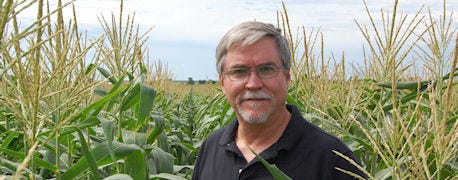
Marty O'Neall knew he made the right decision when he compared harvest machinery costs to his neighbor.
His neighbor follows a traditional "trade-the-combine-in-every-year" model. The cost was very similar to O'Neall's arrangement, a three-year-rental contract with MachineryLink. However, O'Neall, who farms near Cooksville, has virtually zero maintenance or repair costs. Plus, he doesn't have $250,000 tied up in the cost of ownership.
"That means my overall borrowing level is much lower," O'Neall says. "It just made a ton of sense for us. We do not want to own a combine."

HAPPY RENTER: Marty O’Neall is in his 10th season of renting combines with MachineryLink. He like the repair and maintenance plans. Plus, he can have a late model combine without a huge chunk of cash tied up in ownership.
O'Neall first went to MachineryLink 10 years ago. At the time, he was in the process of merging his farm with Mark Scholl's farm. Rather than have two older-model combines, they decided to pursue a rental agreement.
"For us, it made more sense to rent one newer, larger machine than continue with ownership," O'Neall notes.
O'Neall typically signs a three-year contract with MachineryLink. When harvest nears, he keeps in touch with his MachineryLink representative. If he needs it a few weeks early, it's not a problem. He's also had to keep it late before. Again, not an issue.
MachineryLink covers repairs almost 100%, depending on the issue. Oil changes are 100% covered, O'Neall notes. Belts are split 50/50.
"If I have a breakdown in the field, I call MachineryLink and they call the dealer," O'Neall adds. "Though, it's been a while since I broke down in the field."
Before the combine is delivered, MachineryLink goes through the machine and replaces any parts that are prone to excessive wear. If the combine is down for more than 48 hours, O'Neall says MachineryLink will procure another combine and have it on-farm in a couple of days.
"They don't try to low ball the maintenance," he adds. "They do things right."
Harvest tour
MachineryLink is in its 12 year of renting combines. During that time, the company has refined the movement of combines across the country as they follow the various grain harvests, explains Troy Coats, vice president of sales.
The season starts in Oklahoma and northern Texas with wheat harvest. From there, the fleet is trucked to southern Texas for sorghum harvest and wheat harvest in California, Kansas and Nebraska. The third leg of the trip is rice harvest in the Mississippi Delta region. Coats says, they also send some combines to the Pacific Northwest and Idaho for wheat, corn and soybean harvest. The final leg is corn and soybean harvest in the Cornbelt.
"Custom harvesters have been following that loop for decades," Coats says. "It's a proven rotation."
MachineryLink maintains and rents approximately 270 combines. They flex up and down from that number based on customer demand.
In addition to farmers like O'Neall, Coats says they work with a lot of farmers who are looking to add harvest capacity. The shortest contract they write is for one year. The longest is the three year contract.
Each farmer must provide his or her own combine head. O'Neall also utilizes his own precision-guidance equipment.
About the Author(s)
You May Also Like




